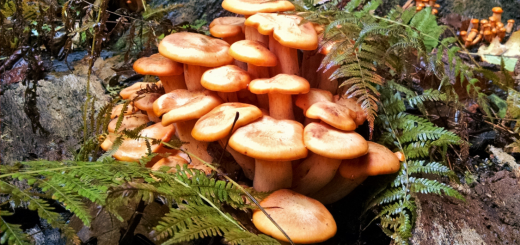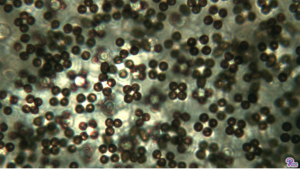#085: Schizophyllum commune, the Mushroom With Over 28,000 Sexes [Archived]
Note: This is an archived post. Read the current version of this post here.
Commonly known as the Split Gill, this little mushroom is easily distinguished by its small gills, which appear to be split lengthwise. The Split Gill is a notable mushroom because of its unusual morphology, ecology, and genetics. Before I get into the bizarre world of fungal sexes, I would like to describe the physical characteristics of this distinctive mushroom.
Personally, I think Schizophyllum commune is one of the most beautiful fungi. I’m not really sure what it is that fascinates me about it, but I always enjoy finding this mushroom. The Split Gill looks very boring from above. It is small, whitish, hairy, and forms irregularly-lobed brackets on decaying wood. Brackets are mushrooms that grow like small shelves off the side of wood. Because brackets grow outward from a central point, their shape can change depending on how they are positioned relative to their substrate. These mushrooms can be fan-shaped to disc shaped and have a small stipe or no stipe at all.
The Split Gill makes up for its boring upper surface with its truly unique lower surface. Its underside is hairy, whitish, and features rudimentary gills. If you look closely, you will notice that its gills, which are little more than folds, each have one slit that runs straight down the middle of the gill. This feature is not found in any other genus of mushrooms and has resulted in S. commune’s common and scientific names (Schizophyllum = “split leaf”). These split gills are actually a method to withstand periods of dry weather. The fertile surface of the mushroom is found on the inner surface of each gill slit. When moisture is plentiful, the slits open up to allow spores to drop to the ground. During dry periods, the mushroom shrivels up and becomes tough or leathery, causing the slits to fold close. This protects the spore surface and allows spores to be released over a long period of time. Even last year’s fruiting bodies will produce spores when the weather is favorable.
S. commune is a cosmopolitan species and can be found on every continent except Antarctica (thus the species name commune, meaning “common”). Very few mushrooms actually have a worldwide distribution, and the Split Gill is one of them. Intensive studies carried out in the 1950’s to 70’s proved this and helped the Split Gill become a model organism for studying mushrooms. S. commune is a decomposer of hardwoods and other plant matter. It causes a white rot in wood, meaning that it decomposes lignin (the material which gives wood its strength). However, this enterprising little fungus has also been known to cause disease in immunocompromised individuals.*
The Split Gill is a very unique fungus. There are a few other species in the genus Schizophyllum, but they are rarely encountered and have much smaller ranges than that of S. commune. All these fungi are placed in the phylum Basidiomycota, class Agaricomycetes, order Agaricales, family Schizophyllaceae, and genus Schizophyllum. The Split Gill and its relatives are grouped with most other gilled mushrooms, but seem to have diverged from the agarics fairly early.
One of the most interesting things about S. commune is its system of sexual reproduction. It is basically the same as that of most fungi, but the Split Gill has acquired some genetic changes that give it a total of over 28,000 distinct sexes. Fungal sex tends to be difficult to understand, but it’s not that hard if you forget almost everything you’ve learned about sexual reproduction in animals and plants. That being said, I have included some comparisons to the higher eukaryotes in an attempt to make this topic a little easier to comprehend.
In order to understand fungal sex, you need to understand the fungal nuclear cycle. If you already do, you can skip to the next paragraph. Otherwise, read on! The fungal nuclear cycle has four stages: gamete, monokaryon, dikaryon, and meiosis. In the gamete stage, the fungus consists of a single spore. This spore is the product of meiosis, so it has one of each chromosome and one of each possible gene. Any cell with only one copy of each chromosome is called a “haploid” cell and is designated by the letter n. The spore stage is somewhat equivalent to a sperm/egg in plants and animals. In suitable conditions, the spore germinates and grows. This is the monokaryon stage. No new genetic material has been added, so each fungal cell contains one nucleus and each nucleus is identical and has exactly one of each chromosome (haploid, n). The monkaryon stage can last a long time in many fungi. During this time, the fungus can grow and produce asexual spores (which will produce new fungi in the monokaryon stage). When it meets a suitable mate, the two fungi will fuse their cells and enter the dikaryon stage. In this stage, each fungal cell has two nuclei that remain separate (dikaryotic, n+n). This stage can also last a long time and the fungus can still grow and produce asexual spores (which will produce new fungi in the dikaryon stage). The final stage – meiosis – only takes place in a few select fungal cells. Only during meiosis do the nuclei fuse with one another to create a diploid (2n) cell. This cell is then split apart into sexual spores (gametes), which each contain one haploid nucleus (n). How long a fungus spends in each phase varies, but fungi spend most of their life as either a monokaryon (n) or as a dikaryon (n+n).
To recap: gamete (n) –> monokaryon (n) –> dikaryon (n+n) –> meiosis (2n) –> gamete (n)
Sexual compatibility in fungi is controlled by genes called “mating types.” In the simplest possible situation, there is one mating type gene with two possible variations (known as “alleles”). Two haploid fungi can fuse to form a dikaryon only if their mating type alleles are different. This system is roughly equivalent to sex in animals, except that there are usually no morphological differences between fungi with different mating types. Men can successfully mate only with women, and “A1” fungi can successfully mate only with “A2” fungi. Thus, there are two “sexes” in this system. Unlike animals/plants, fungi form a long-lived dikaryon with the genotype A1xA2 upon mating. When this fungus produces spores, half of the spores will have the mating type A1 and the other half will have A2. In this system, an individual will be able to mate with half of the population and with half of its siblings.
Mating with your siblings is not good, even in the fungal world. If an organism does mate with its siblings, detrimental recessive genes may be expressed and mutations are allowed to accumulate. Outcrossing (mating with an individual from a different family) provides a greater chance that harmful mutations will stay silent. A simple way to improve the chances of outcrossing is to add another mating type allele. In this case, an A1A2 fungus will still produce A1 and A2 spores that will be able to mate with half of their siblings. However, the population of fungi is 33% A1, 33% A2, and 33% A3. As a result, any spore can mate with 67% of the population. This is greater than the percentage of compatible siblings, so the odds of outcrossing are improved. You can add more alleles to improve the odds further, but any given spore will still be compatible with 50% of its siblings.
You can reduce the percentage of compatible siblings by adding another mating type gene. If there are two mating types with two possible alleles each, then every dikaryotic fungus will have one copy of each mating type gene. They can either be arranged A1B1xA2B2 or A1B2xA2B1. The A and B genes are located on different chromosomes, so they will be distributed randomly to the spores. Possible spore genotypes are: A1B1, A1B2, A2B1, and A2B2. Fungi using this system can mate successfully only if both of their mating type genes are different. For example, the A2B2 spore can mate only with an A1B1 fungus. Since each of the spore genotypes is equally likely, any given spore will be able to mate with only 25% of its siblings. This is a great improvement over the system with one mating type gene.
Various fungi have developed a great many variations on the systems described above. Some of these strategies allow the fungus to mate with itself (which would ensure it can produce sexual spores), while others improve the chances of outcrossing. I will eventually get around to explaining how some of these other systems work, but for now let’s focus on S. commune. The Split Gill’s genetics are designed to encourage as much outcrossing as possible. Not only does it use two different mating type genes, but it has many alleles for each gene: over 300 for the A gene and over 90 for the B gene. This means the Split Gill has over 28,000 possible sexes (distinct combinations of the A and B genes). Any given spore will still be able to mate with 25% of its siblings, but it will also be able to mate with 99.98% of the population. These odds greatly favor outcrossing, which supports genetic variation in the species.
Could this mating type system account for the great success of this global species? Possibly. The Split Gill (which is already one of the most thoroughly-studied mushrooms) and its relatives certainly deserve to be researched further. Their ecology and genetics present a unique opportunity to learn more about what makes mushrooms successful.
* I decided to put this tidbit at the end, so that the more squeamish of you wouldn’t be deterred from reading the explanation of mating types. In one case of S. commune infection, the fungus grew through the roof of a child’s mouth and into her sinuses, where it started forming mushrooms.
See Further:
http://www.mushroomexpert.com/schizophyllum_commune.html
http://botit.botany.wisc.edu/toms_fungi/feb2000.html
http://www.first-nature.com/fungi/schizophyllum-commune.php
http://www.mykoweb.com/CAF/species/Schizophyllum_commune.html
http://blog.mycology.cornell.edu/2010/06/02/a-fungus-walks-into-a-singles-bar/


![#011: Characteristics of Kingdom Fungi [Archived]](https://www.fungusfactfriday.com/wp-content/themes/hueman/assets/front/img/thumb-medium-empty.png)





![#011: Characteristics of Kingdom Fungi [Archived]](https://www.fungusfactfriday.com/wp-content/themes/hueman/assets/front/img/thumb-small-empty.png)


3 Responses
[…] Schizophyllum commune1,10 […]
[…] complicated.1 Schizophyllum commune, for example, has 28,000 possible mating type combinations (see FFF#085 for more on mating types and S. […]
[…] have described the evolution that changed Cryptococcus from an organism with many sexes (see FFF#085 for more on fungi with multiple sexes) into an organism with only two. Originally, Cryptococcus […]